Spatial Correlation between the Changes in Supply and Demand for Water-Related Ecosystem Services
Abstract
1. Introduction
2. Methodology
2.1. Study Site and Data Source
2.2. Quantification of Water-Related Ecosystem Services
2.2.1. Water-Related Ecosystem Services Selection
2.2.2. Water Yield
2.2.3. Soil Conservation
2.2.4. Water Purification
2.3. Framework of Correlation Analysis
- (1)
- WESs supply calculation. Utilizing the Millennium Ecosystem Assessment (MA) framework alongside the Common International Classification of Ecosystem Services (CICES), this study selected vital WESs, specifically, WY, SC, and WP (as depicted in Table 5). Employing the respective ecological models, a spatial mapping approach was employed to compute the supply of these WESs from 2000 to 2020.
- (2)
- WESs demand calculation. Estimating WESs demand involves selecting three socio-economic indicators (HAI, POP, and GDP) to characterize and understand the demand for these services. Employing these indicators, spatial mapping of WESs demand within the study area was conducted, spanning the timeframe from 2000 to 2020.
- (3)
- The study conducts spatial correlation analysis to examine the changes in both the supply and demand of WESs from a zoning perspective. This entails examining the spatial and temporal variations in the supply and demand of WESs in the study area from 2000 to 2020 by employing hotspot analysis to investigate the aggregation/dispersion patterns of supply change and demand change in the WESs. Ecological zoning is carried out based on these changes (categorized as high–medium–low) by overlaying the hotspot analysis results of supply and demand changes. The OPGD method is utilized to analyze the factors affecting different WESs and the relationship between their supply and demand changes in diverse zones. The factor detector is used to assess the impact of WESs demand changes on society, ecology, and nature, revealing the trend (positive/negative) of WESs demand changes on different WESs supply changes. Lastly, ecological management suggestions for balancing WESs supply and demand are proposed based on the spatial correlation of changes in WESs supply and demand across different zones.
2.4. Evaluating the Supply–Demand Relationship of WESs
2.4.1. Quantifying WESs Supply
2.4.2. Quantifying WESs Demand
2.5. Optimal Parameters-Based Geographical Detector
3. Results
3.1. WESs Spatial Pattern of Supply and Demand
3.2. WESs Supply Change and Demand Change Zoning
3.3. Correlation between WESs Supply Change and Demand Change
4. Discussion
4.1. Influencing Factors of the Correlation between WESs Supply and Demand Changes
4.2. Policy Implications
4.3. Limitations and Prospects
5. Conclusions
Author Contributions
Funding
Institutional Review Board Statement
Informed Consent Statement
Data Availability Statement
Acknowledgments
Conflicts of Interest
References
- Costanza, R.; De Groot, R.; Sutton, P.; Van der Ploeg, S.; Anderson, S.J.; Kubiszewski, I.; Farber, S.; Turner, R.K. Changes in the global value of ecosystem services. Glob. Environ. Chang. 2014, 26, 152–158. [Google Scholar] [CrossRef]
- Daily, G.C. (Ed.) . Nature’s Services: Societal Dependence on Natural Ecosystems; Island Press: Washington, DC, USA, 1997; Available online: http://refhub.elsevier.com/S0169-204600221-8/h0055 (accessed on 11 November 2023).
- De Groot, R.S.; Alkemade, R.; Braat, L.; Hein, L.; Willemen, L. Challenges in integrating the concept of ecosystem services and values in landscape planning, management and decision making. Ecol. Complex. 2010, 7, 260–272. [Google Scholar] [CrossRef]
- Xue, Q.; Yang, X.; Wu, F. A three-stage hybrid model for the regional assessment, spatial pattern analysis and source apportionment of the land resources comprehensive supporting capacity in the Yangtze River Delta urban agglomeration. Sci. Total Environ. 2020, 711, 134428. [Google Scholar] [CrossRef] [PubMed]
- Miao, Z.; Baležentis, T.; Tian, Z.; Shao, S.; Geng, Y.; Wu, R. Environmental performance and regulation effect of China’s atmospheric pollutant emissions: Evidence from “three regions and ten urban agglomerations”. Environ. Resour. Econ. 2019, 74, 211–242. [Google Scholar] [CrossRef]
- Liu, C.F.; Wang, C.; Liu, L.C. Spatio-temporal variation on habitat quality and its mechanism within the transitional area of the Three Natural Zones: A case study in Yuzhong county. Geogr. Res. 2018, 37, 419–432. Available online: https://www.mdpi.com/1099-4300/20/6/419 (accessed on 11 November 2023).
- Wood, S.L.; Jones, S.K.; Johnson, J.A.; Brauman, K.A.; Chaplin-Kramer, R.; Fremier, A.; Girvetz, E.; Gordon, L.J.; Kappel, C.V.; Mandle, L.; et al. Distilling the role of ecosystem services in the Sustainable Development Goals. Ecosyst. Serv. 2018, 29, 70–82. [Google Scholar] [CrossRef]
- Costanza, R.; De Groot, R.; Braat, L.; Kubiszewski, I.; Fioramonti, L.; Sutton, P.; Farber, S.; Grasso, M. Twenty years of ecosystem services: How far have we come and how far do we still need to go? Ecosyst. Serv. 2017, 28, 1–6. [Google Scholar] [CrossRef]
- Desai, B.H. 14. United Nations Environment Program (UNEP). 2015. Available online: http://refhub.elsevier.com/S0169-204600221-8/h0180 (accessed on 11 November 2023).
- Assessment, M.E. Millennium Ecosystem Assessment. 2001. Available online: http://chapter.ser.org/europe/files/2012/08/Harris.pdf (accessed on 11 November 2023).
- UNCCD (United Nations Convention to Combat Desertification). Poor Land Use Costs Countries 9 Percent Equivalent of Their GDP; UNCCD: Bonn, Germany, 2018; Available online: https://www.unccd.int/news-events/poor-land-use-costs-countries-9-percentequivalent-their-gdp (accessed on 11 November 2023).
- Zhai, T.; Wang, J.; Jin, Z.; Qi, Y.; Fang, Y.; Liu, J. Did improvements of ecosystem services supply-demand imbalance change environmental spatial injustices? Ecol. Indic. 2020, 111, 106068. [Google Scholar] [CrossRef]
- Bakker, K. Water security: Research challenges and opportunities. Science 2012, 337, 914–915. [Google Scholar] [CrossRef]
- Liu, W.; Zhan, J.; Zhao, F.; Yan, H.; Zhang, F.; Wei, X. Impacts of urbanization-induced land-use changes on ecosystem services: A case study of the Pearl River Delta Metropolitan Region, China. Ecol. Indic. 2019, 98, 228–238. [Google Scholar] [CrossRef]
- Bi, Y.; Zheng, L.; Wang, Y.; Li, J.; Yang, H.; Zhang, B. Coupling relationship between urbanization and water-related ecosystem services in China’s Yangtze River economic Belt and its socio-ecological driving forces: A county-level perspective. Ecol. Indic. 2023, 146, 109871. [Google Scholar] [CrossRef]
- Yang, S.; Bai, Y.; Alatalo, J.M.; Wang, H.; Jiang, B.; Liu, G.; Chen, J. Spatio-temporal changes in water-related ecosystem services provision and trade-offs with food production. J. Clean. Prod. 2021, 286, 125316. [Google Scholar] [CrossRef]
- Xu, Z.; Peng, J.; Dong, J.; Liu, Y.; Liu, Q.; Lyu, D.; Qiao, R.; Zhang, Z. Spatial correlation between the changes of ecosystem service supply and demand: An ecological zoning approach. Landsc. Urban Plan. 2022, 217, 104258. [Google Scholar] [CrossRef]
- Zagonari, F. Using ecosystem services in decision-making to support sustainable development: Critiques, model development, a case study, and perspectives. Sci. Total Environ. 2016, 548, 25–32. [Google Scholar] [CrossRef]
- Xu, Z.; Wei, H.; Fan, W.; Wang, X.; Huang, B.; Lu, N.; Ren, J.; Dong, X. Energy modeling simulation of changes in ecosystem services before and after the implementation of a Grain-for-Green program on the Loess Plateau—A case study of the Zhifanggou valley in Ansai County, Shaanxi Province, China. Ecosyst. Serv. 2018, 31, 32–43. [Google Scholar] [CrossRef]
- Sun, R.; Li, F.; Chen, L. A demand index for recreational ecosystem services associated with urban parks in Beijing, China. J. Environ. Manag. 2019, 251, 109612. [Google Scholar] [CrossRef]
- Qiu, S.; Peng, J.; Dong, J.; Wang, X.; Ding, Z.; Zhang, H.; Mao, Q.; Liu, H.; Quine, T.A.; Meersmans, J. Understanding the relationships between ecosystem services and associated social-ecological drivers in a karst region: A case study of Guizhou Province, China. Prog. Phys. Geogr. Earth Environ. 2021, 45, 98–114. [Google Scholar] [CrossRef]
- Wu, X.; Liu, S.; Zhao, S.; Hou, X.; Xu, J.; Dong, S.; Liu, G. Quantification and driving force analysis of ecosystem services supply, demand and balance in China. Sci. Total Environ. 2019, 652, 1375–1386. [Google Scholar] [CrossRef] [PubMed]
- Peng, J.; Wang, X.; Liu, Y.; Zhao, Y.; Xu, Z.; Zhao, M.; Wu, J. Urbanization impact on the supply-demand budget of ecosystem services: Decoupling analysis. Ecosyst. Serv. 2020, 44, 101139. [Google Scholar] [CrossRef]
- Baró, F.; Gómez-Baggethun, E.; Haase, D. Ecosystem service bundles along the urban-rural gradient: Insights for landscape planning and management. Ecosyst. Serv. 2017, 24, 147–159. [Google Scholar] [CrossRef]
- Chen, X.; Li, F.; Li, X.; Hu, Y.; Hu, P. Evaluating and mapping water supply and demand for sustainable urban ecosystem management in Shenzhen, China. J. Clean. Prod. 2020, 251, 119754. [Google Scholar] [CrossRef]
- Liang, J.; Li, S.; Li, X.; Li, X.; Liu, Q.; Meng, Q.; Lin, A.; Li, J. Trade-off analyses and optimization of water-related ecosystem services (WRESs) based on land use change in a typical agricultural watershed, southern China. J. Clean. Prod. 2021, 279, 123851. [Google Scholar] [CrossRef]
- Liu, Y.; Yang, Y.; Wang, Z.; An, S. Quantifying Water Provision Service Supply, Demand, and Spatial Flow in the Yellow River Basin. Sustainability 2022, 14, 10093. [Google Scholar] [CrossRef]
- Wu, D.; Zheng, L.; Wang, Y.; Gong, J.; Li, J.; Chen, Q. Characteristics of urban expansion in megacities and its impact on water-related ecosystem services: A comparative study of Chengdu and Wuhan, China. Ecol. Indic. 2024, 158, 111322. [Google Scholar] [CrossRef]
- Li, J.; Xie, B.; Gao, C.; Zhou, K.; Liu, C.; Zhao, W.; Xiao, J.; Xie, J. Impacts of natural and human factors on water-related ecosystem services in the Dongting Lake Basin. J. Clean. Prod. 2022, 370, 133400. [Google Scholar] [CrossRef]
- Huang, L.; Chen, X.; Ye, C.; Yuan, Z.; He, K. Multiscale effects and drivers of landscape heterogeneity for water-related ecosystem services in urban agglomerations. Hydrol. Process. 2024, 38, e15081. [Google Scholar] [CrossRef]
- Liu, H.; Hou, L.; Kang, N.; Nan, Z.; Huang, J. A meta-regression analysis of the economic value of grassland ecosystem services in China. Ecol. Indic. 2022, 138, 108793. [Google Scholar] [CrossRef]
- Zhang, W. Constructing ecological interaction networks by correlation analysis: Hints from community sampling. Netw. Biol. 2011, 1, 81. Available online: https://www.researchgate.net/profile/Wenjun-Zhang-10/publication/228560951_Constructing_ecological_interaction_networks_by_correlation_analysis_Hints_from_community_sampling/links/575435f108ae10d9337a0dfb/Constructing-ecological-interaction-networks-by-correlation-analysis-Hints-from-community-sampling.pdf (accessed on 16 November 2023).
- Raiesi, F.; Beheshti, A. Evaluating forest soil quality after deforestation and loss of ecosystem services using network analysis and factor analysis techniques. Catena 2022, 208, 105778. [Google Scholar] [CrossRef]
- Sun, J.; Li, Y.P.; Gao, P.P.; Suo, C.; Xia, B.C. Analyzing urban ecosystem variation in the City of Dongguan: A stepwise cluster modeling approach. Environ. Res. 2018, 166, 276–289. [Google Scholar] [CrossRef]
- Abdullah, A.Y.; Biswas, R.K.; Chowdhury, A.I.; Billah, S.M. Modeling soil salinity using direct and indirect measurement techniques: A comparative analysis. Environ. Dev. 2019, 29, 67–80. [Google Scholar] [CrossRef]
- Luo, L.; Mei, K.; Qu, L.; Zhang, C.; Chen, H.; Wang, S.; Di, D.; Huang, H.; Wang, Z.; Xia, F.; et al. Assessment of the Geographical Detector Method for investigating heavy metal source apportionment in an urban watershed of Eastern China. Sci. Total Environ. 2019, 653, 714–722. [Google Scholar] [CrossRef] [PubMed]
- Belsti, Y.; Moran, L.; Du, L.; Mousa, A.; De Silva, K.; Enticott, J.; Teede, H. Comparison of machine learning and conventional logistic regression-based prediction models for gestational diabetes in an ethnically diverse population; the Monash GDM Machine learning model. Int. J. Med. Inform. 2023, 179, 105228. [Google Scholar] [CrossRef] [PubMed]
- Liu, S.; Shi, H.; Niu, J.; Chen, J.; Kuang, X. Assessing future socioeconomic drought events under a changing climate over the Pearl River basin in South China. J. Hydrol. Reg. Stud. 2020, 30, 100700. [Google Scholar] [CrossRef]
- Fang, Z.; Chen, J.; Liu, G.; Wang, H.; Alatalo, J.M.; Yang, Z.; Mu, E.; Bai, Y. Framework of basin eco-compensation standard valuation for cross-regional water supply–A case study in northern China. J. Clean. Prod. 2021, 279, 123630. [Google Scholar] [CrossRef]
- Zhang, Y.; Sun, M.; Yang, R.; Li, X.; Zhang, L.; Li, M. Decoupling water environment pressures from economic growth in the Yangtze River Economic Belt, China. Ecol. Indic. 2021, 122, 107314. [Google Scholar] [CrossRef]
- Zheng, Y.; He, Y.; Chen, X. Spatiotemporal pattern of precipitation concentration and its possible causes in the Pearl River basin, China. J. Clean. Prod. 2017, 161, 1020–1031. [Google Scholar] [CrossRef]
- Zhang, B.; Yin, J.; Jiang, H.; Chen, S.; Ding, Y.; Xia, R.; Wei, D.; Luo, X. Multi-source data assessment and multi-factor analysis of urban carbon emissions: A case study of the Pearl River Basin, China. Urban Clim. 2023, 51, 101653. [Google Scholar] [CrossRef]
- Bryan, B.A.; Ye, Y.; Connor, J.D. Land-use change impacts on ecosystem services value: Incorporating the scarcity effects of supply and demand dynamics. Ecosyst. Serv. 2018, 32, 144–157. [Google Scholar] [CrossRef]
- Jury, W.A.; Vaux, H.J., Jr. The emerging global water crisis: Managing scarcity and conflict between water users. Adv. Agron. 2007, 95, 1–76. [Google Scholar]
- Shrestha, S.; Bhatta, B.; Shrestha, M.; Shrestha, P.K. Integrated assessment of the climate and landuse change impact on hydrology and water quality in the Songkhram River Basin, Thailand. Sci. Total Environ. 2018, 643, 1610–1622. [Google Scholar] [CrossRef] [PubMed]
- Du Preez, C.C.; Van Huyssteen, C.W. Threats to soil and water resources in South Africa. Environ. Res. 2020, 183, 109015. [Google Scholar] [CrossRef] [PubMed]
- Rasul, G. Food, water, and energy security in South Asia: A nexus perspective from the Hindu Kush Himalayan region. Environ. Sci. Policy 2014, 39, 35–48. [Google Scholar] [CrossRef]
- Qi, X.; Wang, R.Y.; Li, J.; Zhang, T.; Liu, L.; He, Y. Ensuring food security with lower environmental costs under intensive agricultural land use patterns: A case study from China. J. Environ. Manag. 2018, 213, 329–340. [Google Scholar] [CrossRef]
- Mohsen, M.S. Water strategies and potential of desalination in Jordan. Desalination 2007, 203, 27–46. [Google Scholar] [CrossRef]
- Sharp, R.; Douglass, J.; Wolny, S.; Arkema, K.; Bernhardt, J.; Bierbower, W.; Chaumont, N.; Denu, D.; Fisher, D.; Glowinski, K.; et al. InVEST 3.9. 0. post195+ ug. gbc51afe User’s Guide; The Natural Capital Project; Stanford University: Stanford, CA, USA, 2020. [Google Scholar]
- Jiang, Y.; Ouyang, B.; Yan, Z. Multiscale Analysis for Identifying the Impact of Human and Natural Factors on Water-Related Ecosystem Services. Sustainability 2024, 16, 1738. [Google Scholar] [CrossRef]
- Fan, F.; Liu, Y.; Chen, J.; Dong, J. Scenario-based ecological security patterns to indicate landscape sustainability: A case study on the Qinghai-Tibet Plateau. Landsc. Ecol. 2021, 36, 2175–2188. [Google Scholar] [CrossRef]
- Fu, B.; Ouyang, Z.; Shi, P.; Fan, J.; Wang, X.; Zheng, H.; Zhao, W.; Wu, F. Current condition and protection strategies of Qinghai-Tibet Plateau ecological security barrier. Bull. Chin. Acad. Sci. 2021, 36, 1298–1306. [Google Scholar] [CrossRef]
- Zhang, S.; Yang, P.; Xia, J.; Wang, W.; Cai, W.; Chen, N.; Hu, S.; Luo, X.; Li, J.; Zhan, C. Land use/land cover prediction and analysis of the middle reaches of the Yangtze River under different scenarios. Sci. Total Environ. 2022, 833, 155238. [Google Scholar] [CrossRef]
- Peng, J.; Yang, Y.; Xie, P.; Liu, Y.X. Zoning for the construction of green space ecological networks in Guangdong Province based on the supply and demand of ecosystem services. Acta Ecol. Sin. 2017, 37, 4562–4572. [Google Scholar]
- Villamagna, A.M.; Angermeier, P.L.; Bennett, E.M. Capacity, pressure, demand, and flow: A conceptual framework for analyzing ecosystem service provision and delivery. Ecol. Complex. 2013, 15, 114–121. [Google Scholar] [CrossRef]
- Han, R.; Feng, C.C.; Xu, N.; Guo, L. Spatial heterogeneous relationship between ecosystem services and human disturbances: A case study in Chuandong, China. Sci. Total Environ. 2020, 721, 137818. [Google Scholar] [CrossRef]
- Li, L.; Zhu, L.Q.; Zhu, W.B.; Xu, S.B.; Li, Y.H.; Ma, H. The correlation between ecosystem service value and human activity intensity and its trade-offs—Take Qihe River basin for example. China Environ. Sci. 2020, 40, 365–374. [Google Scholar] [CrossRef]
- Yang, J.; Wang, J.; Xu, C.; Liu, Y.; Yin, Q.; Wang, X.; Wang, L.; Wu, Y.; Xiao, G. Rice supply flows and their determinants in China. Resour. Conserv. Recycl. 2021, 174, 105812. [Google Scholar] [CrossRef]
- Song, Y.; Wang, J.; Ge, Y.; Xu, C. An optimal parameters-based geographical detector model enhances geographic characteristics of explanatory variables for spatial heterogeneity analysis: Cases with different types of spatial data. GIScience Remote Sens. 2020, 57, 593–610. [Google Scholar] [CrossRef]
- Wang, J.; Xu, C. Geodetector: Principle and prospective. Acta Geogr. Sin. 2017, 72, 116–134. [Google Scholar]
- Huan, H.; Wang, J.; Teng, Y. Assessment and validation of groundwater vulnerability to nitrate based on a modified DRASTIC model: A case study in Jilin City of northeast China. Sci. Total Environ. 2012, 440, 14–23. [Google Scholar] [CrossRef]
- Chen, J.; Yang, S.T.; Li, H.W.; Zhang, B.; Lv, J.R. Research on geographical environment unit division based on the method of natural breaks (Jenks). Int. Arch. Photogramm. Remote Sens. Spat. Inf. Sci. 2013, 40, 47–50. [Google Scholar] [CrossRef]
- Maliqi, E.; Singh, S.K. Quantitative estimation of soil erosion using open-access earth observation data sets and erosion potential model. Water Conserv. Sci. Eng. 2019, 4, 187–200. [Google Scholar] [CrossRef]
- Felipe-Lucia, M.R.; Soliveres, S.; Penone, C.; Fischer, M.; Ammer, C.; Boch, S.; Allan, E. Land-use intensity alters networks between biodiversity, ecosystem functions, and services. Proc. Natl. Acad. Sci. USA 2020, 117, 28140–28149. [Google Scholar] [CrossRef]
- Zorrilla-Miras, P.; Palomo, I.; Gómez-Baggethun, E.; Martín-López, B.; Lomas, P.L.; Montes, C. Effects of land-use change on wetland ecosystem services: A case study in the Doñana marshes (SW Spain). Landsc. Urban Plan. 2014, 122, 160–174. [Google Scholar] [CrossRef]
- Im, R.Y.; Kim, J.Y.; Nishihiro, J.; Joo, G.J. 2020. Large weir construction causes the loss of seasonal habitat in riverine wetlands: A case study of the Four Large River Projects in South Korea. Ecol. Eng. 2020, 152, 105839. [Google Scholar] [CrossRef]
- Chen, W.; Chi, G.; Li, J. The spatial association of ecosystem services with land use and land cover change at the county level in China, 1995–2015. Sci. Total Environ. 2019, 669, 459–470. [Google Scholar] [CrossRef] [PubMed]
- Wang, Y.; Li, X.; Xin, L.; Tan, M. Farmland marginalization and its drivers in mountainous areas of China. Sci. Total Environ. 2020, 719, 135132. [Google Scholar] [CrossRef] [PubMed]
- Xiangmei, M.; Feifei, F.; Lifeng, W. Prediction of major pollutants discharge from wastewater in 31 cities of China. Sustain. Prod. Consum. 2021, 26, 54–64. [Google Scholar] [CrossRef]
- Colelli, F.P.; Emmerling, J.; Marangoni, G.; Mistry, M.N.; De Cian, E. Increased energy use for adaptation significantly impacts mitigation pathways. Nat. Commun. 2022, 13, 4964. [Google Scholar] [CrossRef]
- Aryal, J.P.; Sapkota, T.B.; Khurana, R.; Khatri-Chhetri, A.; Rahut, D.B.; Jat, M.L. Climate change and agriculture in South Asia: Adaptation options in smallholder production systems. Environ. Dev. Sustain. 2020, 22, 5045–5075. [Google Scholar] [CrossRef]
- Ministry of Ecology and Environment. The National Strategy for Climate Change Adaptation 2035. 2022. Available online: https://www.mee.gov.cn/xxgk2018/xxgk/xxgk03/202206/t20220613_985261.html (accessed on 19 November 2023).
- Kraaijenbrink, P.D.; Stigter, E.E.; Yao, T.; Immerzeel, W.W. Climate change decisive for Asia’s snow meltwater supply. Nat. Clim. Chang. 2021, 11, 591–597. [Google Scholar] [CrossRef]
- Wang, T.; Zhao, Y.; Xu, C.; Ciais, P.; Liu, D.; Yang, H.; Yao, T. Atmospheric dynamic constraints on Tibetan Plateau freshwater under Paris climate targets. Nat. Clim. Chang. 2021, 11, 219–225. [Google Scholar] [CrossRef]
- Sondershaus, F.; Moss, T. Your resilience is my vulnerability: ‘Rules in use’ in a local water conflict. Soc. Sci. 2014, 3, 172–192. [Google Scholar] [CrossRef]

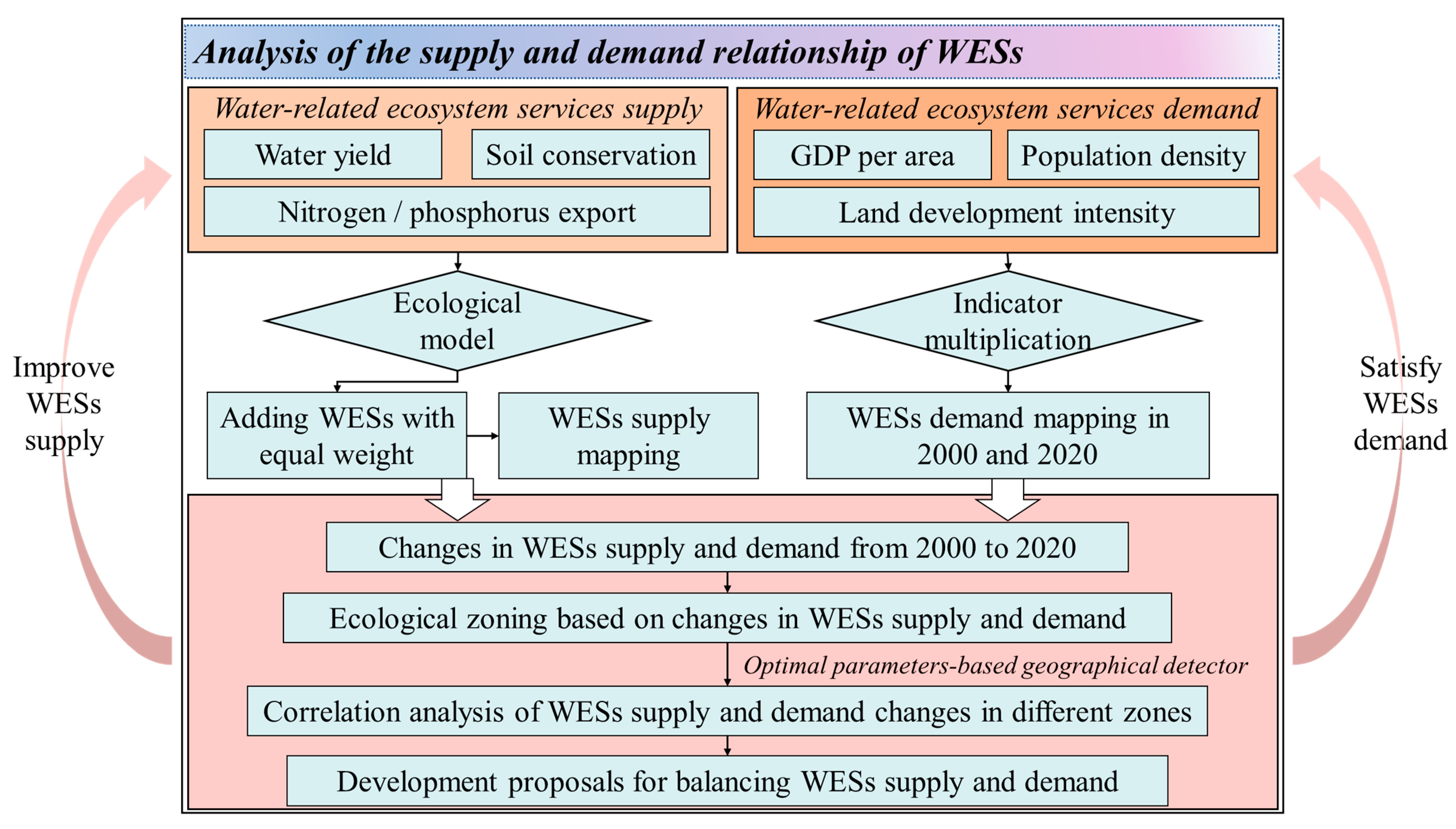



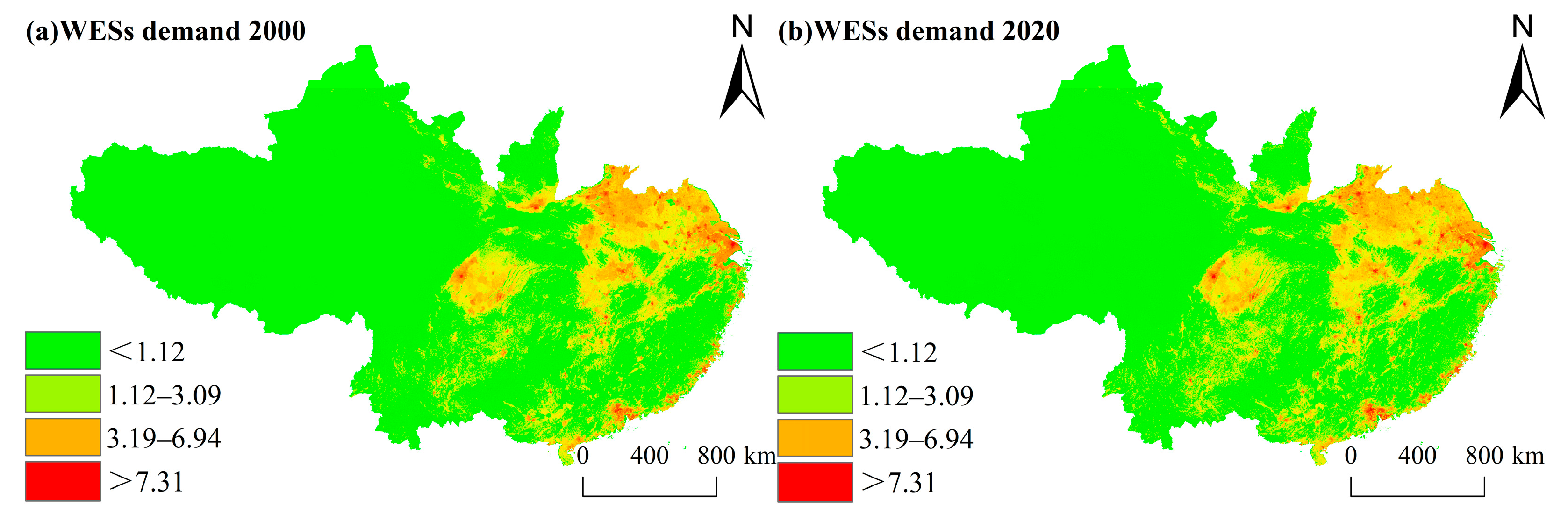
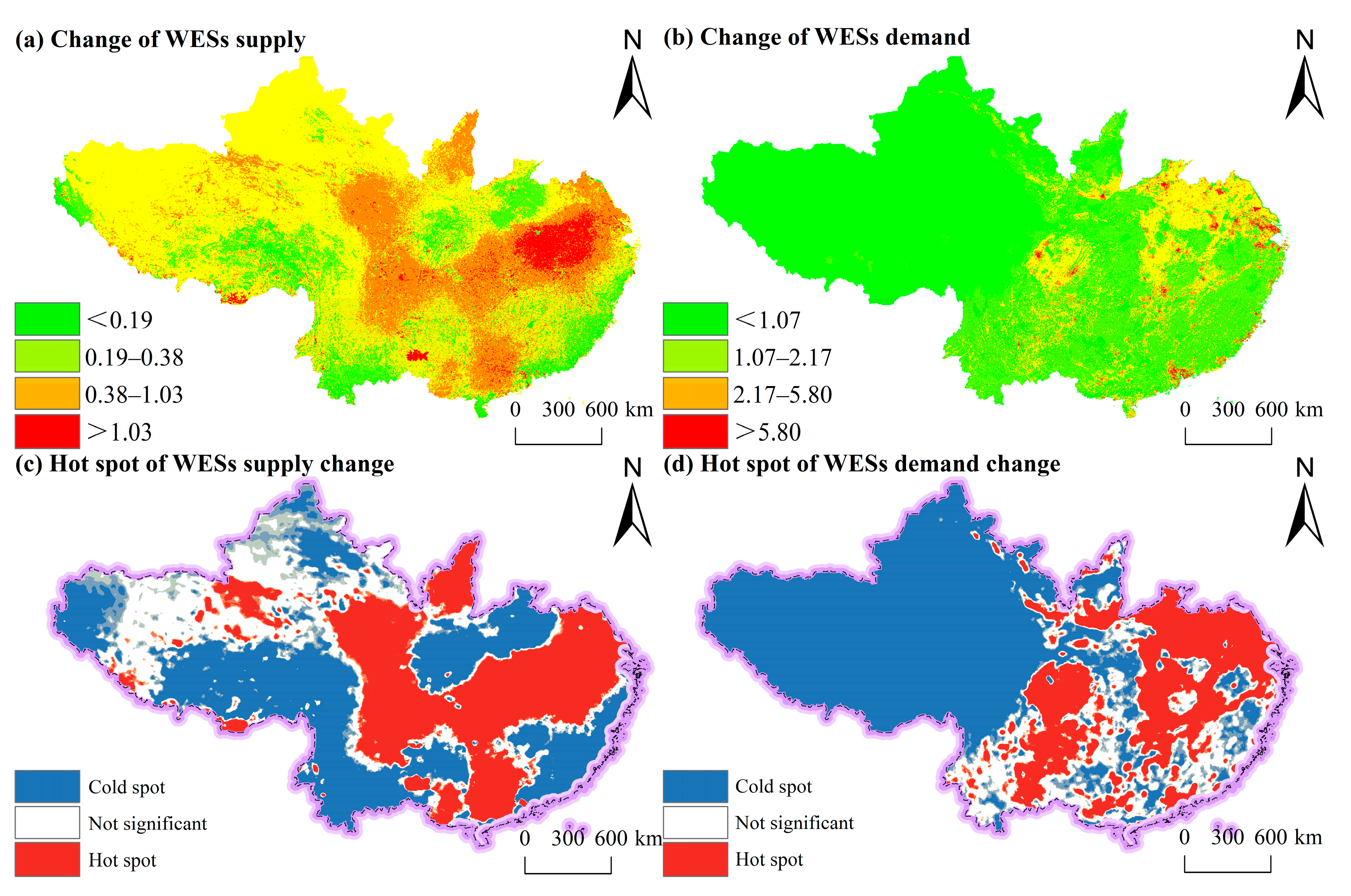
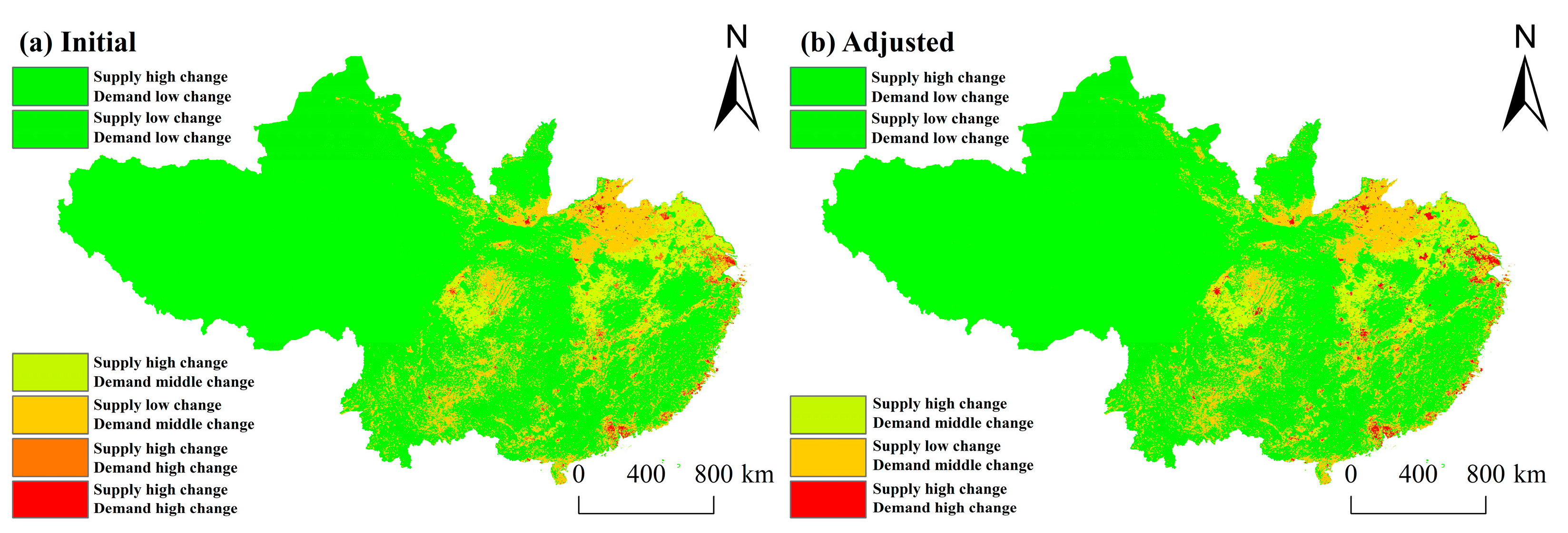

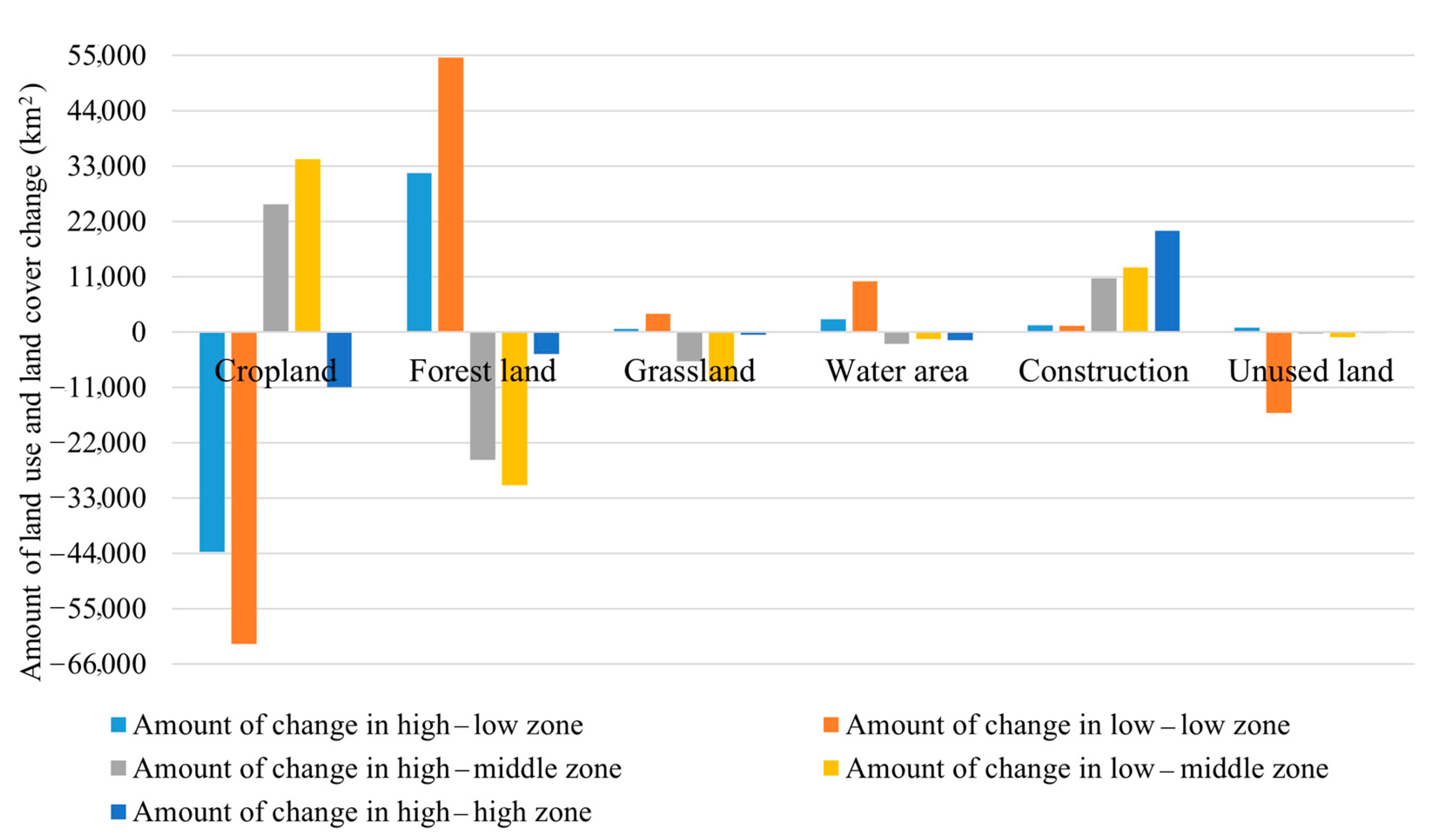
| Target Layer | Criterion Layer | Indicator Layer | Year | Spatial Resolution | Data Resource |
|---|---|---|---|---|---|
| Suitability | Nature | Digital elevation model (DEM) | 2020 | 30 m | http://www.gscloud.cn, accessed on 21 September 2023 |
| Slope (SLO) | 2020 | Extracted from elevation | |||
| Aspect | 2020 | ||||
| Normalized difference vegetation index (NDVI) | 2020 | 1 km | https://www.resdc.cn, accessed on 11 October 2023 | ||
| Net primary productivity (NPP) | 2020 | ||||
| Soil types (Soil) | 2020 | https://www.ncdc.ac.cn/portal, accessed on 1 October 2023 | |||
| Soil erosion types (SER) | 2020 | ||||
| Distance to water source (DWA) | 2000, 2020 | http://www.openstreetmap.org, accessed on 6 October 2023 | |||
| Climate | Annual mean temperature (TEM) | https://www.geodata.cn, accessed on 11 September 2023 | |||
| Annual mean precipitation (PRE) | |||||
| Annual mean evaporation (EVA) | |||||
| Annual mean relative humidity (RHU) | |||||
| Total annual evapotranspiration (EVA) | |||||
| Direct normal irradiation (DNI) | |||||
| Sunshine hours (SSD) | |||||
| Land use and land cover (LULC) | Percentage of cropland land (CLP) | 2000, 2020 | 30 m | https://www.resdc.cn, accessed on 19 September 2023 | |
| Percentage of forest land (FLP) | |||||
| Percentage of grassland (GLP) | |||||
| Percentage of water area (WLP) | |||||
| Percentage of construction (ConsP) | 1 km | The percentage of land area designated for construction use in the region represents the characteristics of LULC composition. | |||
| Coordination | Socio- economic | Population (POP) | 2000, 2020 | 1 km | https://www.worldpop.org, accessed on 23 September 2023 |
| Nighttime lighting data (NLD) | 2000, 2020 | ||||
| Gross domestic product (GDP) | 2000, 2020 | ||||
| Traffic location | Distance to government (DGO) | 2020 | http://www.openstreetmap.org, accessed on 6 October 2023 | ||
| Distance to road (DRO) | 2020 | ||||
| Distance to highway (DHI) | 2020 | ||||
| Distance to train station (DTS) | 2020 | ||||
| Distance to hospital (DHO) | 2020 | ||||
| Distance to school (DSC) | 2020 | ||||
| Distance to bus stops (DBS) | 2020 |
| LULC | Root_depth | Kc | LULC_veg | Usle_c | Usle_p | Load_n | Load_p | Eff_n | Eff_p | Crit_len_n | Crit_len_p | Proportion_subsurface_n |
|---|---|---|---|---|---|---|---|---|---|---|---|---|
| Cropland | 300 | 1.1 | 1 | 0.3 | 0.2 | 15.5 | 1.73 | 0.25 | 0.25 | 30 | 30 | 0.4 |
| Forest land | 3500 | 1 | 1 | 0.006 | 1 | 2.5 | 0.15 | 0.7 | 0.7 | 300 | 300 | 0.15 |
| Grassland | 800 | 0.7 | 1 | 0.02 | 1 | 6 | 0.8 | 0.48 | 0.48 | 150 | 150 | 0.15 |
| Water area | 1 | 1.05 | 0 | 0 | 0 | 0.001 | 0.001 | 0.05 | 0.05 | 30 | 30 | 0.25 |
| Construction | 1 | 0.43 | 0 | 0 | 0 | 11 | 1.8 | 0.05 | 0.05 | 30 | 30 | 0.3 |
| Other land | 1 | 0.5 | 0 | 0 | 1 | 11 | 1.8 | 0.05 | 0.05 | 30 | 30 | 0.1 |
| River | 2000 | 2020 | |
|---|---|---|---|
| Xiangjiang River | Observed data | 764.53 | 641.02 |
| Modeled data | 813.08 | 625.07 | |
| Error rate/% | −6.35 | 2.49 | |
| Zishui River | Observed data | 243.33 | 283.55 |
| Modeled data | 222.86 | 278.03 | |
| Error rate/% | 8.41 | 1.95 | |
| Dongting Lake Basin | Observed data | 2184.81 | 2803.21 |
| Modeled data | 2016.27 | 2667.79 | |
| Error rate/% | 7.71 | 4.83 |
| Measured Value | Calculated Value | Error Rate/% | ||
|---|---|---|---|---|
| LULC | Soil Loss/Tons·km−2·yr−1 | LULC | Soil Loss/Tons·km−2·yr−1 | |
| Economic fruit tree | 1223.3 | Forest land | 1441.5 | 17.8 |
| Greening grassland | 1162.6 | 24.0 | ||
| Bare land | 1972.9 | −27.0 | ||
| Average | 1452.9 | −0.8 | ||
| Indicator | Basis for Selecting Indicators |
|---|---|
| WY | WY plays a crucial role in maintaining human life and well-being by serving as a foundational cornerstone for various life-sustaining activities. |
| SC | Soil conservation is crucial for upholding ecological balance, ensuring food security, and fostering sustainable development. |
| WP | Resolving water pollution in the YRB is absolutely vital, particularly focusing on tackling pollution in lakes, reservoirs, and water bodies with high levels of nitrogen and phosphorus. |
| Supply | Demand | |
|---|---|---|
| Hot spot | 20,999.19 | 12,666,110.17 |
| Not significant | 1337.70 | 345,383.50 |
| Cold spot | 12,669.91 | 333,017.28 |
| WY-Factors | DTS | DBS | DRO | DSC | DHO | DGO | DHI | DNI |
| q statistic | 0.2631 ** | 0.3743 ** | 0.2421 ** | 0.3787 ** | 0.3709 ** | 0.3701 ** | 0.3743 ** | 0.6486 ** |
| WY-Factors | Aspect | DEM | SER | EVA | GDP | NDVI | NLD | NPP |
| q statistic | 0.1478 ** | 0.5474 ** | 0.5634 ** | 0.3628 ** | 0.4612 ** | 0.4604 ** | 0.4327 ** | 0.6138 ** |
| WY-Factors | POP | PRE | RHU | SLO | Soil | SSD | TEM | DWA |
| q statistic | 0.4992 ** | 0.8925 ** | 0.7331 ** | 0.0402 ** | 0.5678 ** | 0.6940 ** | 0.5735 ** | 0.0500 ** |
| WY-Factors | CLP | FLP | GLP | WLP | ConsP | HAI | ||
| q statistic | 0.5148 ** | 0.5547 ** | 0.6234 ** | 0.5713 ** | 0.5342 ** | 0.5182 ** | ||
| SC-Factors | DTS | DBS | DRO | DSC | DHO | DGO | DHI | DNI |
| q statistic | 0.0325 ** | 0.0739 ** | 0.0445 ** | 0.0747 ** | 0.0813 ** | 0.0775 ** | 0.0739 ** | 0.1089 ** |
| SC-Factors | Aspect | DEM | SER | EVA | GDP | NDVI | NLD | NPP |
| q statistic | 0.0188 ** | 0.1169 ** | 0.1534 ** | 0.0359 ** | 0.1097 ** | 0.1256 ** | 0.1437 ** | 0.1338 ** |
| SC-Factors | POP | PRE | RHU | SLO | Soil | SSD | TEM | DWA |
| q statistic | 0.1348 ** | 0.1379 ** | 0.1530 ** | 0.2296 ** | 0.2362 ** | 0.0737 ** | 0.0510 ** | 0.0235 ** |
| SC-Factors | CLP | FLP | GLP | WLP | ConsP | HAI | ||
| q statistic | 0.2233 ** | 0.2284 ** | 0.2045 ** | 0.1939 ** | 0.1953 ** | 0.2301 ** | ||
| NE-Factors | DTS | DBS | DRO | DSC | DHO | DGO | DHI | DNI |
| q statistic | 0.1590 ** | 0.2066 ** | 0.2235 ** | 0.2603 ** | 0.2618 ** | 0.2568 ** | 0.2066 ** | 0.2409 ** |
| NE-Factors | Aspect | DEM | SER | EVA | GDP | NDVI | NLD | NPP |
| q statistic | 0.0563 ** | 0.2647 ** | 0.2504 ** | 0.1794 ** | 0.2507 ** | 0.1932 ** | 0.2684 ** | 0.2511 ** |
| NE-Factors | POP | PRE | RHU | SLO | Soil | SSD | TEM | DWA |
| q statistic | 0.2805 ** | 0.2692 ** | 0.2464 ** | 0.0321 ** | 0.1910 ** | 0.2394 ** | 0.2481 ** | 0.0342 ** |
| NE-Factors | CLP | FLP | GLP | WLP | ConsP | HAI | ||
| q statistic | 0.3263 ** | 0.2696 ** | 0.3310 ** | 0.2473 ** | 0.2463 ** | 0.3501 ** | ||
| PE-Factors | DTS | DBS | DRO | DSC | DHO | DGO | DHI | DNI |
| q statistic | 0.1626 ** | 0.2110 ** | 0.2368 ** | 0.2691 ** | 0.2699 ** | 0.2610 ** | 0.2110 ** | 0.2191 ** |
| PE-Factors | Aspect | DEM | SER | EVA | GDP | NDVI | NLD | NPP |
| q statistic | 0.0483 ** | 0.2736 ** | 0.2554 ** | 0.1631 ** | 0.2622 ** | 0.1714 ** | 0.2809 ** | 0.2370 ** |
| PE-Factors | POP | PRE | RHU | SLO | Soil | SSD | TEM | DWA |
| q statistic | 0.2930 ** | 0.2194 ** | 0.2151 ** | 0.0552 ** | 0.1960 ** | 0.2080 ** | 0.2233 ** | 0.0367 ** |
| PE-Factors | CLP | FLP | GLP | WLP | ConsP | HAI | ||
| q statistic | 0.3475 ** | 0.2942 ** | 0.3571 ** | 0.2644 ** | 0.2799 ** | 0.3866 ** |
| WESs | High Supply–Low Demand Zone | Low Supply–Low Demand Zone | High Supply–Middle Demand Zone | Low Supply–Middle Demand Zone | High Supply–High Demand Zone |
|---|---|---|---|---|---|
| WY | 0.275 ** | 0.275 ** | 0.245 ** | 0.225 ** | 0.158 ** |
| SC | 0.259 ** | 0.240 ** | 0.224 ** | 0.217 ** | 0.169 ** |
| NE | 0.240 ** | 0.240 ** | 0.231 ** | 0.235 ** | 0.252 ** |
| PE | 0.226 ** | 0.244 ** | 0.301 ** | 0.323 ** | 0.421 ** |
Disclaimer/Publisher’s Note: The statements, opinions and data contained in all publications are solely those of the individual author(s) and contributor(s) and not of MDPI and/or the editor(s). MDPI and/or the editor(s) disclaim responsibility for any injury to people or property resulting from any ideas, methods, instructions or products referred to in the content. |
© 2024 by the authors. Licensee MDPI, Basel, Switzerland. This article is an open access article distributed under the terms and conditions of the Creative Commons Attribution (CC BY) license (https://creativecommons.org/licenses/by/4.0/).
Share and Cite
Jiang, Y.; Ouyang, B.; Yan, Z. Spatial Correlation between the Changes in Supply and Demand for Water-Related Ecosystem Services. ISPRS Int. J. Geo-Inf. 2024, 13, 68. https://doi.org/10.3390/ijgi13030068
Jiang Y, Ouyang B, Yan Z. Spatial Correlation between the Changes in Supply and Demand for Water-Related Ecosystem Services. ISPRS International Journal of Geo-Information. 2024; 13(3):68. https://doi.org/10.3390/ijgi13030068
Chicago/Turabian StyleJiang, Yuncheng, Bin Ouyang, and Zhigang Yan. 2024. "Spatial Correlation between the Changes in Supply and Demand for Water-Related Ecosystem Services" ISPRS International Journal of Geo-Information 13, no. 3: 68. https://doi.org/10.3390/ijgi13030068
APA StyleJiang, Y., Ouyang, B., & Yan, Z. (2024). Spatial Correlation between the Changes in Supply and Demand for Water-Related Ecosystem Services. ISPRS International Journal of Geo-Information, 13(3), 68. https://doi.org/10.3390/ijgi13030068





